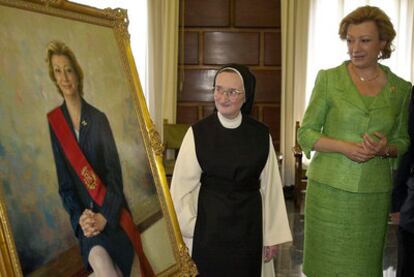The million-dollar question that is plaguing a convent of Zaragoza nuns
Tax office called in to investigate source of 450,000 euros stolen from congregation
A sign written in Gothic letters announces the Cistercian monastery of Santa Lucía, in Zaragoza. Another sign warns about security measures on the premises, although these were of little effect on February 27, when somebody allegedly entered and made off with 1.5 million eurosin cash. All of a sudden, the 16 cloistered nuns who live inside the convent became the center of attention as the media sought to learn more about these millionaire sisters who, in theory, are bound by vows of poverty.
The thief's identity is the least mysterious element in this whole story. Certainly, it was a very crafty person who knew exactly where the booty was, since only the strictly necessary locks were picked, police say. But what everyone is really wondering is what this small congregation of isolated women was doing with 1.5 million euros in cash - mostly in 500-euro notes - stashed away in plastic bags inside a wardrobe. The theft has thrown up other questions too. Like, why did the sisters change their version of events a day after their initial complaint to the police, saying that it was actually just 450,000 euros that was missing, and that the money was not "40 years' worth of savings" as originally reported, but income they had earned? They now maintain that the funds were generated by book binding, restoration work and parishioner donations, as well as from the sale of paintings by Sister Isabel Guerra, whose hyper-realistic works command as much as 48,000 euros, according to the mother superior. The money had recently been withdrawn from a bank in order to hand out as charity, they said.
The sisters could face prison terms of one to five years, if found guilty of tax evasion
But these explanations did not convince the police, who reported the case to the tax authorities on suspicion that it might be undeclared money. The tax agency will now check whether the congregation is up to date with its fiscal obligations; the nuns' lawyer, Jesús García Huici, said that his clients file taxes as self-employed workers specializing in the graphic-arts sector.
Religious communities get no special tax breaks, and their filing conditions are similar to those of foundations. The only exception is that congregations do not need to declare charity. They do, however, need to report any activity that is a source of income for them. If it is demonstrated, for instance, that the congregation deliberately avoided paying VAT on their restoration work or on the sold paintings, the sisters could face prison terms of one to five years, and a fine up to six times the evaded amount.
García Huici rejects this possibility, but avoids answering questions about the origin of the money or the reason why the figure of the amount stolen was reduced in the police report. "I am unaware that there is a first version of events. All I have is a written statement saying that 450,000 euros was stolen. When I see a different statement, then maybe I'll ask them about it."
According to sources close to the investigation, on February 28 the nuns reported to police that "a million and a half euros were missing" from the wardrobe where they kept it, inside plastic bags. The police confirmed that three doors had been forced open: the entrance door to the convent, the door to the room where the money was kept, and the door of the wardrobe that contained it.
Francisco Martínez García, the religious community delegate at the Zaragoza archbishopric, told the media he was puzzled at the amount of cash the nuns had lying around, but said it was quite possible that it came from the sale of Sister Guerra's paintings and the congregation's restoration and binding work. These specialties meant this particular community were "better off" than those at other convents, aides of the archbishop said.
Days at the Santa Lucía convent are not as dull as one may imagine. The nuns "lead a very busy life," according to one of their neighbors. Their white van is constantly coming and going to deliver their work, another neighbor says. Despite being a cloistered congregation, the sisters are often seen walking in twos in Zaragoza.
The best-known member of the community is Sister Isabel Guerra, and people who know what life at the convent is like say the hypothesis about the sale of her paintings is the most likely one of all. Her paintings are very much in demand, and until 2005, the Madrid-based Sokoa Gallery managed her sales and organized her shows. The gallery's new owners decided to drop her from the catalogue, but apparently the artist does not need intermediaries. "People commission work from her directly. They're sold even before they are painted," says a friend who would rather remain anonymous. "I wouldn't be surprised if the stolen money was the proceeds of the sale of her work," adds a collector who owns a Guerra painting but declined to reveal its price tag.
Meanwhile, the nuns are not shedding light on matters. They are not talking to the press and will not answer the phone, and the situation will remain like this "for some time," says a sister speaking from behind a wooden grate. "Let's hope this all blows over soon," she sighs.








































